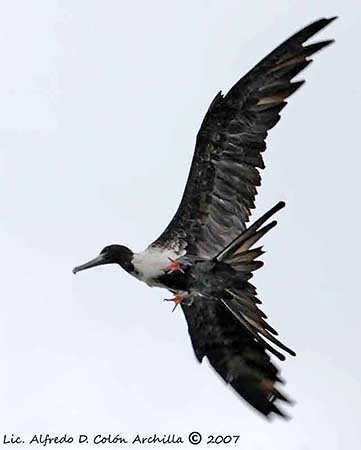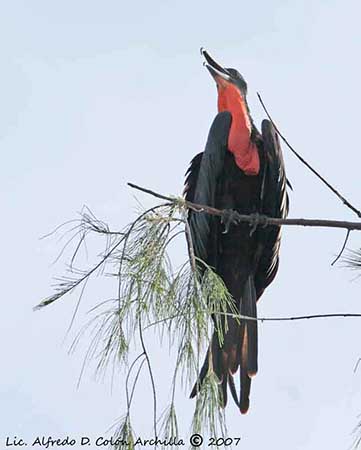
Magnificent Frigatebird
Fregata magnificens
Suliformes Order – Fregatidae Family
BIOMETRICS:
Length : 95-110 cm
Wingspan: 215-245 cm
Weight: M : 1200g; F : 1700g
DESCRIPTION:
Magnificent Frigatebird is a large sea bird often in flight. It has long, narrow and pointed wings, tail deeply notched and a long hooked bill.
Male is glossy black. Its black feathers show many glints, and display different colours under the sunlight. Magnificent Frigatebird has purple glints.
Throat displays an orange membranous pouch, becoming bright red in breeding plumage. This pouch inflates during courtship displays by male.
Magnificent Frigatebird presents a faint dark bar across upper wing coverts. Bill is grey and hooked, legs are black, and feet are united by a small membrane at base. Eye-ring is blackish.

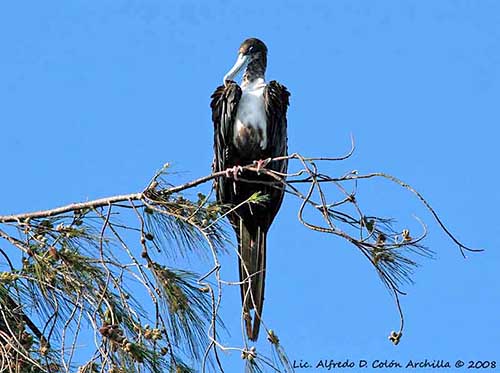
Female has black head and neck, white chest, and conspicuous pale brown wing bar on upper wing coverts. Eye-ring is purple-blue, and membranous pouch is grey to crimson. Legs are reddish.
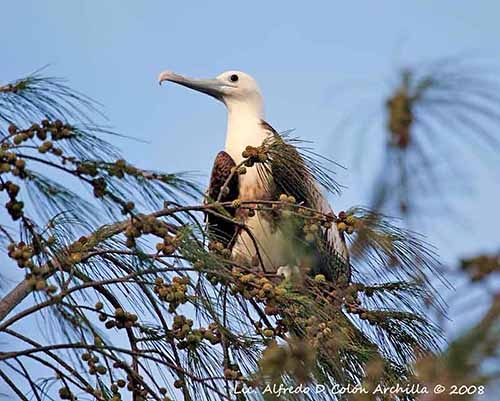
Immature has white head and chest, and an obvious pale wing bar. Bill, eye-ring, and legs are pale blue.
VOICE: SOUNDS BY XENO-CANTO
Magnificent Frigatebird is generally silent, except in the colony where male utters rapid, crackling, drumming and quavering sounds and snapping bill. We can also hear throaty sounds in breeding period.
HABITAT:
Magnificent Frigatebird is the characteristic tropical sea coast frigatebird. But it lives all year round as well inland as on surrounding areas shores. We find it on coasts, including the wet mangroves and the harbours.
RANGE:
It nests on small rocky islands towards Boa Vista and Cape Verde Islands. It also nests in the West Indies, in Central America, on Fernando Noronha Island, and in Brazil Islands.
BEHAVIOUR:
Magnificent Frigatebird uses its agile flight for catching preys. It fishes while skimming over water, capturing fish with its bill on the surface. It drops vertically onto its prey and catches it abruptly, without any dive under water. Its plumage is not waterproof, and prevents it from diving into the water. It also steals preys to other sea birds, harassing them while flying until they let go or regurgitate their preys. It is able to perform rapid and dramatic behaviour for feeding.
Usually, it doesn’t land on the water and it doesn’t walk on the ground. Strictly diurnal, it sleeps inland at night. It rests on rocks and island vegetation and on boat masts. At other times, it takes sun bathes lying with held wings backwards and turning them towards the sky.
However, recent studies tell that this bird flies in thermals currents at night too.
During courtship displays, male excessively inflates it membranous red pouch similar to a balloon (this pouch can remain inflated more than 20 minutes), and displays with head backwards and open wings. In other display, male remains quietly perched on low bush, looking at female flying above its head. It shakes the head from side to side, performs flapping wings and sings. If these displays are positive, female lands close to the male.
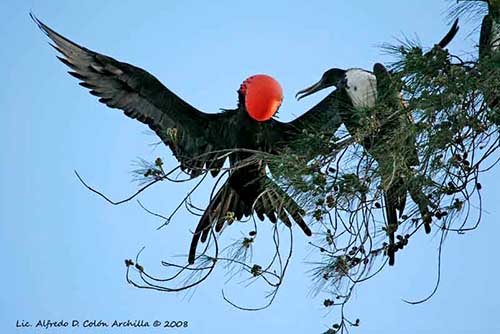
Magnificent Frigatebird is usually solitary outside of colonies, but it will feed in loose flocks when food resources are abundant. It is a gregarious bird.
Usually, Magnificent Frigatebird flies high above the coasts or coastal water, and rarely moves away from continents.
FLIGHT:
Magnificent Frigatebird has perfect body, adapted to dynamic flights, with occasional and deep wing beats, moving with its long notched tail. It performs maintained flight, high in the air, with arched wings, raising and gliding effortless. In flight, its silhouette resembles that of raptor.
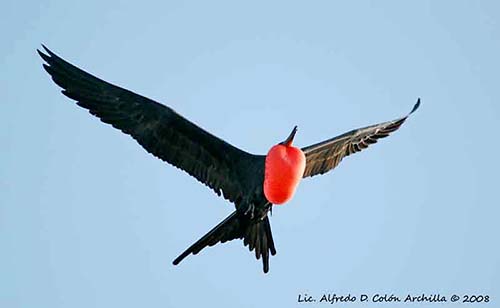
REPRODUCTION:
Magnificent Frigatebird nests in colonies, often in small groups. Nest is located at the top of a bush or a tree, or in rocky bank if vegetation is absent. It is a semi-spherical platform, made with sticks, and lined with feathers and bit of bones. Nest is built by both adults.
Female lays only one single white egg. Incubation lasts about seven weeks, shared by both adults. Chick is naked at hatching, but it rapidly gets a grey-white down.
It can fly at about 4 to 6 months, but it depends from parents for feeding during at least six months, and then, female alone feeds it during 8 months more. That explains why Magnificent Frigatebird doesn’t breed each year.
As large as adults, young waits for parents during long time, in full sun. It adopts a special posture, with head downwards, as dead. But when parents come back, it awakes, raising the head and calling until adults open their bills. Young plunges its head into the parent’s throat and swallows all the ingested food during their fishing parties.

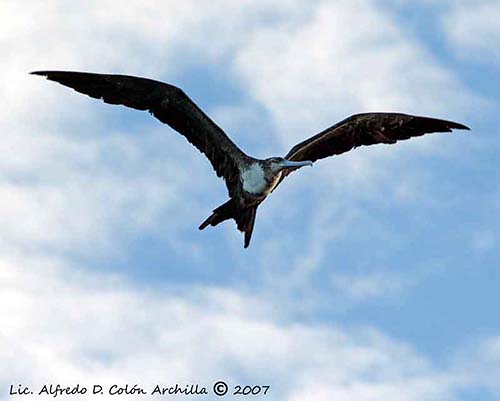
DIET:
Magnificent Frigatebird feeds on flying fishes, its preferred food, squids, crabs, jellyfishes and plankton. It harasses other species to make them regurgitate their preys, it follows the boats for taking fishes thrown into water, and it takes beached fishes, and steals broods on the beaches, for sea birds’ eggs and chicks, always while flying.
It is one of the main predators of young sea turtles, which it catches on the ground on in water. It also frequents garbage and harbours accesses where it finds fish remains.
PROTECTION/THREATS / STATUS:
Magnificent Frigatebird species is endangered, persecuted by fishermen particularly in the Cape Verde Islands. Destruction of its habitat by extension of coastal habitation and disturbance in colonies, are very important threats for this bird, maybe living its last decades.
Fr: Frégate superbe
All : Prachtfregattvogel
Esp : Rabihorcado Magnífico
Ital: Fregata magnifica
Nd: Amerikaanse Fregatvogel
Russe: Великолепный фрегат
Sd: Praktfregattfågel
Photos de Alfredo Colón
Puerto Rico Wildlife
Text by Nicole Bouglouan
Sources :
HANDBOOK OF THE BIRDS OF THE WORLD vol 1 by Josep del Hoyo-Andrew Elliot-Jordi Sargatal - Lynx Edicions - ISBN: 8487334105
All About Birds (Cornell Lab of Ornithology)
What Bird-The ultimate Bird Guide (Mitchell Waite)
Wikipedia (Wikipedia, The Free Encyclopedia)
Arthur Grosset's Birds (Arthur Grosset)
